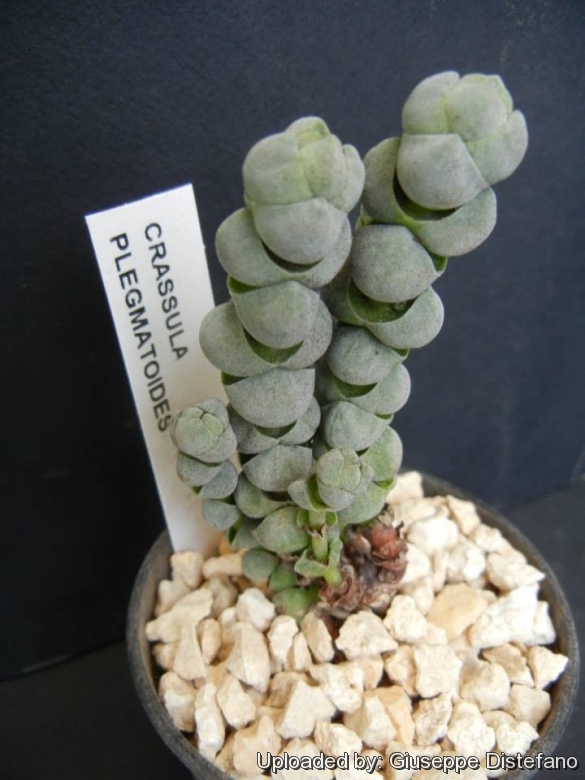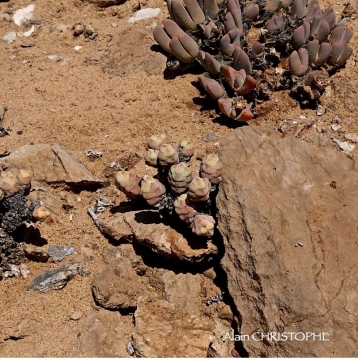
Crassula plegmatoides Photo by: Giuseppe Distefano
Origin and Habitat: Crassula plegmatoidesSN|26958]]SN|26958]] has a restricted distribution at the southern end of the Namib coastal desert between Port Nolloth in Namaqualand in South Africa and Alexander Bay and northwards into the Buchu Mountains (Bocgoeberge) in south-western Namibia.
Altitude: 100-300 metres above sea level.
Habitat and ecology: It grows in very dry coastal areas usually on quartz gravel and rocks where there is much drifting sand. It is in theory a winter rainfall area, never freezing since at sea level, but so dry that the plants are mostly oppportunistic and will grow when they are lucky enough to get water.
Synonyms:
See all synonyms of Crassula plegmatoides
back
Accepted name in llifle Database:Crassula plegmatoides FriedrichMitt. Bot. Staatssamml. München 6: 627 1967Synonymy: 2
back
Description: Crassula plegmatoidesSN|26653]]SN|26958]] is a neat little species forming light greyish green columns of thick rounded felty leaves that fit on and into each-other perfectly. It produces open, somewhat hairy heads of cream flowers in late Summer or Autumn. The name Crassula artaSN|12127]]SN|12129]] (a synonym of Crassula deceptorSN|12129]]SN|12127]]) is often wrongly applied to this species.
Habit: It is a spreading perennials-geophyte with short stems that grows in clumps with a few branches from base.
Stems: Columnar unbranched, occasionally branched from base, erect or prostrate, completely coated by the close-pressed leaves that form a 4-angled fat, compact, velvety, grey, column 80-150 mm tall when in flower.
Leaves: Stem-enclosing, adpressed, fleshy, broadly ovate to almost globular, 5-9 x 7-13 mm, gray-green (similar to those of Crassula columellaSN|26958]]SN|26653]] but more coarsely papillate), forming a short 4-angled column 10-15 mm in diameter
Inflorescences: The peduncle is 30-60 mm long and is covered with recurved hairs. Sepals 1.5-2 mm, triangular, fleshy, grey-green.The corolla is cream, fading to brown. Petals 2-3 mm, fused at base. Stamens with brown anthers.
Blooming season: Late summer-early autumn
Bibliography: Major references and further lectures
1) Doreen Court "Succulent Flora of Southern Africa" CRC Press, 01/giu/2000
2) Alfred Byrd Graf “Exotica, series 4 international: pictorial cyclopedia of exotic plants from tropical and near-tropic regions” Roehrs Co. Publishers, 1985
3) Vera Higgins “Crassulas in Cultivation.” 1964
4) Otto A. Leistner “Flora of southern Africa” 14: 194 1985
5) Gordon Rowley “Crassula: A Grower's Guide” Cactus & Company, 2003
6) Jacobsen “Lexicon of succulent plants” Littlehampton Book Services Ltd. 1974
7) James Cullen, Sabina G. Knees, H. Suzanne Cubey "The European Garden Flora Flowering Plants: A Manual for the Identification of Plants Cultivated in Europe, Both Out-of-Doors and Under Glass" Cambridge University Press, 11/ago/2011
8) Dr J.P. Roux “Flora of South Africa” 2003
9) Domitilla Raimondo “Red list of South African plants 2009” South African National Biodiversity Institute, 2009
10) Werner Rauh “The Wonderful World of Succulents: Cultivation and Description of Selected Succulent Plants Other Than Cacti” Smithsonian Institution Press, 1984
 Crassula plegmatoides Photo by: © Plantemania
Crassula plegmatoides Photo by: © PlantemaniaSend a photo of this plant.The gallery now contains thousands of pictures, however it is possible to do even more. We are, of course, seeking photos of species not yet shown in the gallery but not only that, we are also looking for better pictures than those already present.
Read More... Cultivation and Propagation: Crassula plegmatoidesSN|26958]]SN|26958]] are quite smart for the extremely dry circumstances where these plants grow. But not so difficult to grow if you remember not to over-water in the Summer when they're taking their rest. This is a small plant that is perfect for a window garden, dish garden that will take full sun, little water, the leaves are gray and look like upside down ice cream cones. It may be difficult to find but worth the bother. Outdoors OK only if protected from winter rain.In cultivation they are spring and autumn grower (summer dormant). When there is too much water available in combination with too less light, the leaves won't form full columns anymore and you will see a piece of stem between the leaf pairs which will make the sight less pretty.
Soil: They are tolerant of a wide range of soils and habitats, but prefer a very porous potting mix to increase drainage. You can grow a plant in a 6-10 cm pot for years and have perfectly happy plants. For best results, use a shallow pot.
Watering: It is in theory a winter grower, but the area of origin is so dry that the plants are mostly oppportunistic and will grow when they are lucky enough to get water so provide some water all year around. So keep it on the drier side than other Crassulas. During the winter months, water only when the soil becomes completely dry. Wet soil quickly causes root and stem rot, especially during chilly winter months, but can re-root if taken care of. No water should ever be allowed to stand around the roots. Low ambient humidity is always needed. Roots will rot in ever damp soil.
Fertilization: The plants are fertilized only once during the growing season with a balanced fertilizer diluted to ½ the recommended strength.
Sun Exposure: A sunny position brings out the best colours, it should be protected from too much exposure in Summer. They do not do well in full shade as they tend to etiolate, fall over and rot easily.
Pest & diseases: Crassulas are sensitive to mealybugs.
Rot: Rot is only a minor problem with Crassula if the plants are watered and “aired” correctly. If they are not, fungicides won't help all that much. Care must be given in watering, keeping them warm and wet while growing, and cooler and dry when dormant.
Hardiness: Although the plants will survive mild frost if kept dry (hardy as low as -5° C) they should be protected from frost to prevent scarring. USDA 9b-12
Use: It is an excellent potted plant great for windowsill culture as well as in rock gardens. Indoors only in brightest position.
Pruning: Remove old leaves from plant base and dead flower spikes only.
Maintenance: Re-establish from cuttings if it becomes untidy.
Propagation: They are easily propagated by the removal of off shoots, remove a lateral shoot and insert the basal part buried in the soil. This shoot should root within a month, and small offshoots will form at the base. They can also be grown from seed.












